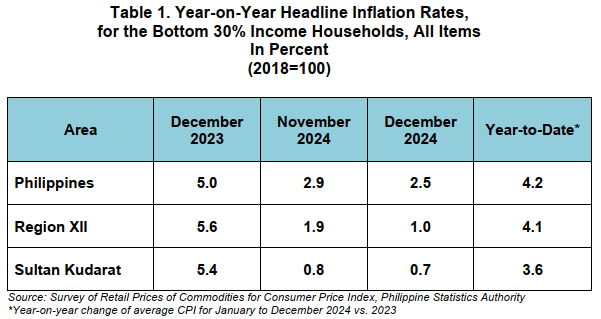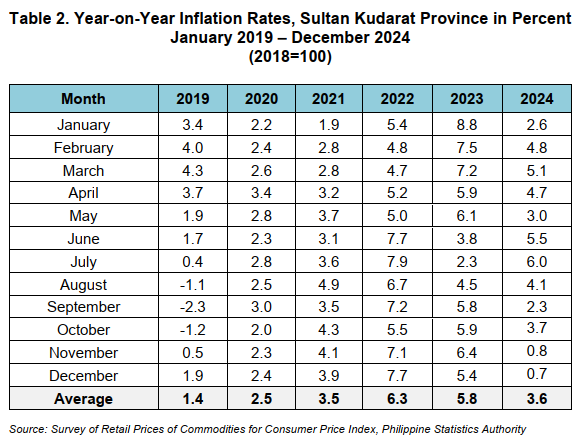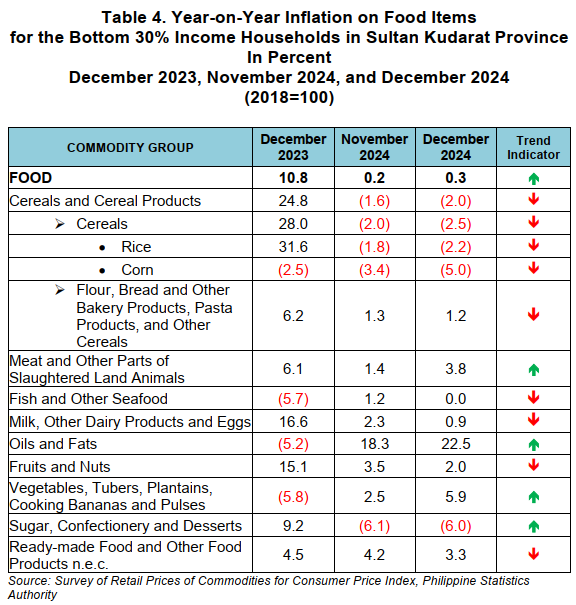Summary Inflation Report Consumer Price Index for the
Bottom 30% Income Households
Sultan Kudarat Province
DECEMBER 2024
(2018=100)

Inflation in Sultan Kudarat Province
1. Overall Inflation
The overall inflation rate for the bottom 30% income households in the province of Sultan Kudarat slow down to 0.7 percent in December 2024, compared to 0.8 percent reported in November 2024. In December 2023 inflation was higher at 5.4 percent. (Table 1, Table 2 and Figure 1)


1.1. Main Drivers to the Downtrend of Inflation Rate of the Bottom 30% Income Households
The main source of the downtrend of inflation in the bottom 30% income households in the province for December 2024 was brought about by the lower annual growth rate in the index of Housing, Water, Electricity, Gas and Other Fuels at 0.9 percent inflation compared to 2.0 percent in November 2024. This was followed by Clothing and Footwear at 0.3 percent compared to 0.5 percent in November 2024, and Furnishings, Household Equipment and Routine Household Maintenance at 3.3 percent compared to 3.5 percent in November 2024.
Health also contributed to the downtrend of inflation in December 2024 at 1.4 percent compared 1.5 percent in November 2024.
Among the thirteen commodity groups only Transport continued to deflate at -0.4 percent deflation compared to -1.7 percent deflation in November 2024.
Meanwhile, the indices of the rest of commodity groups retained their previous month's inflation rate. (Table 3)

1.2. Main Contributors to the Overall Inflation
The following commodity groups were the top three contributors to the overall inflation for the bottom 30% income households during the month:
a. Food and Non-Alcoholic Beverages with 31.7 percent share;
b. Restaurants and Accommodation Services with 24.2 percent share; and
c. Housing, Water, Electricity, Gas and Other Fuels with 15.5 percent share.
Food Inflation
The food inflation for the bottom 30% income households in the province increased to 0.3 percent compared to its 0.2 percent reported in November 2024. In December 2023, food inflation was higher at 10.8 percent.
The following food groups showed higher inflation during the month compared to November 2024.
a. Meat and other parts of slaughtered land animals at 3.8 percent compared to 1.4 percent;
b. Oils and Fats at 22.5 percent compared to 18.3 percent;and
c. Vegetables, tubers, plantains, cooking bananas and pulses at 5.9 percent compared to 2.5 percent.
In contrast, five (5) food groups showed lower inflation during the month.
a. Flour, Bread and Other Bakery Products, Pasta Products, and Other Cereals at 1.2 percent compared to 1.3 percent;
b. Fish and other seafood at 0.0 percent compared to 1.2 percent;
c. Milk, other dairy products and eggs at 0.9 percent compared to 2.3 percent;
d. Fruits and nuts at 2.0 percent compared to 3.5 percent; and
e. Ready-made food and other food products n.e.c at 3.3 percent 4.2 percent.
Three food groups showed deflation during the month.
a. Rice at -2.2 percent deflation;
b. Corn at -5.0 percent deflation; and
c. Sugar, confectionery and desserts at -6.0 percent deflation (Table 4).

Main Contributors to the Food Inflation of the Bottom 30% Income Households
The food groups with the highest contribution to food inflation during the month were the following:
a. Vegetables, tubers, plantains, cooking bananas and pulses with 264.7 percent share;
b. Meat and other parts of slaughtered land animals with 183.0 percent share; and
c. Oils and Fats with 141.9 percent share.
TECHNICAL NOTES
Consumer Price Index (CPI):
❖A measure of the change in the average retail prices of a fixed basket of goods and services commonly purchased by households relative to base year.
❖It measures the composite change in the consumer prices of various commodities overtime.
❖It stands for the percentage change in the average prices of goods and services commonly bought by a group of consumers from the base year.
Components of the CPI:
Market Basket
❖refers to sample of goods and services commonly purchased by a particular group of consumers in a particular area.
Weight
❖a value attached to a commodity or group of commodities to indicate the relative importance of that commodity or group of commodities in the market basket.
Base Period
❖a period usually a year, at which the index number is set to 100 or it is the reference point of the index number series.
Index Method
❖gives the formula used in computing the index number.
Sample Outlets
❖establishment or retail outlets where prices of commodities/services are collected or quoted.
Inflation Rate (IR)
❖rate of change in the average price level as measured by the CPI between two periods.
❖it is equivalent to the decline in the internal purchasing of the peso.
❖it is derived indicator by comparing the CPI between two periods, usually a year.
Approved for Release

MARIFI P. DE ASIS
(Supervising Statistical Specialist)
OIC- Chief Statistical Specialist
PSA-Sultan Kudarat Province
For inquiries, please contact:
LOVELY JOY M. PARAS
Administrative Aide VI
Provincial Focal Person
Telefax Number: PLDT-(064) 562-4052

